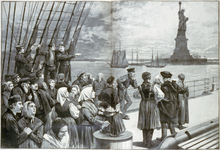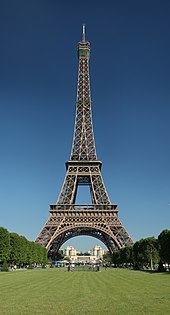Landmark
This article needs additional citations for verification. (January 2016) |

A landmark is a recognizable[1] natural or artificial feature used for navigation, a feature that stands out from its near environment and is often visible from long distances.
In modern day use, the term can also be applied to smaller structures or features, that have become local or national symbols.
Etymology

In old English the word landmearc (from land + mearc (mark)) was used to describe a boundary marker, an "object set up to mark the boundaries of a kingdom, estate, etc.".[2] Starting from around 1560, this understanding of "landmark" was replaced by a more general one. A landmark became a "conspicuous object in a landscape".
A landmark literally meant a
In urban studies as well as in geography, a landmark is furthermore defined as an external point of reference that helps orientation in a familiar or unfamiliar environment.[4] Landmarks are often used in verbal route instructions ("Turn left at the big church and then right over the bridge.")
Types

Landmarks are usually classified as either natural landmarks or human-made landmarks, both are originally used to support navigation on finding directions. A variant is a
Natural
Natural landmarks can be characteristic features, such as mountains or plateaus. Examples of natural landmarks are Mount Everest in the Himalayas, Table Mountain in South Africa, Mount Ararat in Turkey, Uluru in Australia, Mount Fuji in Japan and the Grand Canyon in the United States. Trees might also serve as local landmarks, such as jubilee oaks or conifers. Some landmark trees may be named, such as Queen's Oak, Hanging Oak and Centennial Tree. Bases of fallen trees, known in this context as rootstocks, are used as navigational aids on high-resolution maps and in the sport of orienteering.[5] Because most woods have many fallen trees, generally only very large rootstocks are mapped.
Human made
In the modern sense, landmarks are usually referred to as
See also
- Boundary marker
- Contemporary history
- Cultural heritage management
- Cultural heritage tourism
- National landmark (disambiguation)
- National symbol
References
- ^ "LANDMARK | meaning in the Cambridge English Dictionary". dictionary.cambridge.org. Retrieved 2 August 2020.
- ^ "Online Etymology Dictionary". Etymonline.com. Retrieved 25 January 2016.
- ^ "Landmarker".
- ^ Lynch, Kevin. "The image of the city". MIT Press, 1960, p. 48
- ^ International Specification for Control Descriptions. International Orienteering Federation. 2018.
